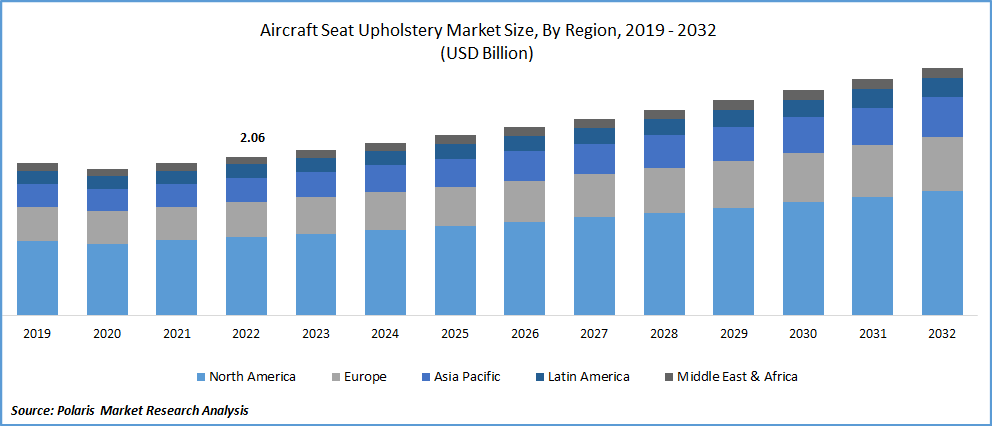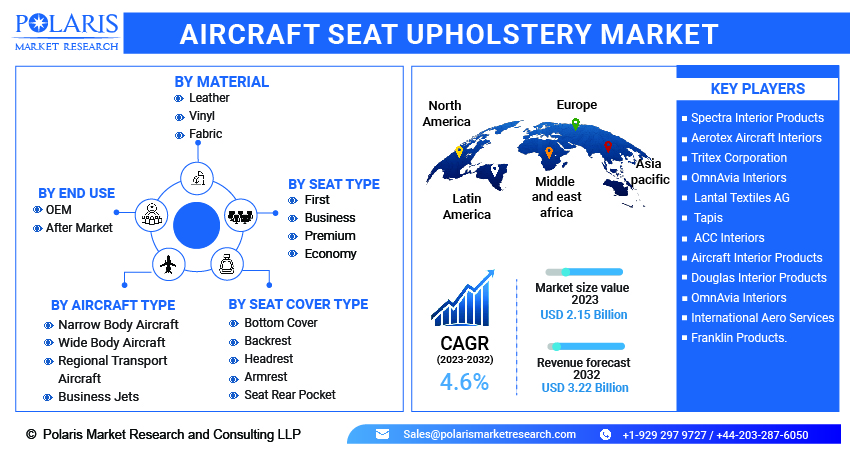
Aircraft Seat Upholstery Market Share, Size, Trends, Industry Analysis Report
By Material (Leather, Vinyl, Fabric); By Seat Cover Type; By Seat Type; By Aircraft Type; By End Use; By Region; Segment Forecast, 2023 - 2032
- Published Date:May-2023
- Pages: 114
- Format: PDF
- Report ID: PM3206
- Base Year: 2022
- Historical Data: 2019-2021
Report Outlook
The global aircraft seat upholstery market was valued at USD 2.06 billion in 2022 and is expected to grow at a CAGR of 4.6% during the forecast period. Aviation Industry is expanding quickly and will do so in the future. As per data published by the ICAO (International Civil Aviation Organization) in 20 years, air travel will rise by an average of 4.3%/year. The aviation sector will support 15.5 million direct jobs and $1.5 trillion in global GDP if this growth trajectory is followed through to 2036. These figures may increase to 97.8 Mn employment & USD 5.7 trillion in GDP once accounts of global tourism are considered. This will fuel the growth of the market as it will create a wide range of opportunities for the growth in upcoming years.

Know more about this report: Request for sample pages
Airlines all around the world are working to provide more comfortable seating and other services, that's why older planes are being refitted with new seat upholstery. Upgrading aircraft seats is a typical trend in the airline business as the old seats become antiquated and the cabin interiors grow uninteresting after a few years after bringing the aircraft into service. Existing airplane seats have been replaced with new ones as a result of the development of cutting-edge, lightweight materials for cabin seating. Additionally, business jet owners like having their cabin seats customized, so that's why aftermarket businesses now provide a wide variety of designs and materials for this purpose.
The responsibility for lowering the cost of air travel lies on low-cost carriers. These airlines, sometimes known as budget airlines, offer low-cost tickets with average to below-average service in comparison to full-service airlines. Low costs and promotional offers are the main factors affecting the low-cost carrier market. The low-cost model has been quite effective for short-haul travel, increasing demand for narrow-body aircraft.
Adopting this strategy aims to offer affordable services to the increasing middle class in developing countries. Low-cost airlines usually buy narrow body aircraft due to their inclination for short flights and the simplicity of maintenance. The surge in demand for narrow gauge has indeed had a negative impact on the market for aeroplane seat upholstery.

Know more about this report: Request for sample pages
Industry Dynamics
Growth Drivers
The aircraft seat upholstery market is driven by the increasing demand for comfortable and lightweight seats in commercial and military aircraft. The use of advanced materials such as lightweight fabrics, leather, and synthetic materials in seat upholstery is also a major factor driving the market growth. The incorporation of advanced technologies such as fire retardant and antimicrobial properties in seat upholstery is also expected to fuel the market growth. In addition, the increasing demand for private jets and business jets is also expected to drive the market growth.
With the rise in disposable income and the growing middle-class population, the demand for air travel is increasing, leading to an increase in the demand of the product. The development of new materials and technologies, such as lightweight and durable fabrics, is driving the market growth. Regulations mandating the use of fire-resistant materials in aircraft seat upholstery are driving the market growth. The rise in the number of low-cost carriers is driving the market growth as these carriers require cost-effective solutions for their seat upholstery. The growth in the number of aircraft deliveries is driving the market growth as new aircraft require seat upholstery. The increase in the demand for luxury and comfort in aircraft seats is driving the market growth.
Report Segmentation
The market is primarily segmented based on material, seat cover type, seat type, aircraft type, end use and region.
|
By Material |
By Seat Cover Type |
By Seat Type |
By Aircraft Type |
By End Use |
By Region |
|
|
|
|
|
|
Know more about this report: Request for sample pages
Leather Segment is expected to witness fastest growth over the forecast period
Leather material is expected to have a higher growth rate in coming years due its wide usage in the aircraft industry. Leather is popular for its durability and premium look, while textile is popular for its lightweight and breathable properties. These factors determine the price, weight and comfort of the aircraft seat, and in turn, influence the growth of the market. Additionally, with the increasing demand for lightweight materials in the aerospace industry, the demand for lightweight materials in the aircraft seat upholstery market is also increasing, which is further driving the market growth.
The use of fabric material in aircraft seat upholstery can have a significant impact on the growth of the market in several ways. First, fabric materials are often preferred for their durability and ease of maintenance, which can make them a more cost-effective option for airlines. Additionally, fabric materials are also known for their comfort, which can help to improve the overall passenger experience.
Furthermore, fabric materials can also be designed to be fire-resistant and to meet other safety requirements which make it suitable for use in the aviation industry. As a result, the use of fabric materials in aircraft seat upholstery can help to drive growth in the market by increasing demand from airlines and other end-users.
Armrest accounted for the largest market share in 2022
Armrests are a critical aspect of aircraft seat design as they provide comfort and support to passengers during flight. They can also be used to improve the overall aesthetic of the seat and can be used to store various items such as drinks, snacks, and personal electronic devices. The increasing focus on passenger comfort and the growing demand for premium seating options in the aviation industry are some of the factors that are driving the growth of the aircraft seat upholstery market.
As airlines continue to invest in the development of new and innovative seating solutions, the demand for armrests is expected to grow, in turn, boosting the growth of the aircraft seat upholstery market.
Economy Seat Type is expected to witness fastest growth
Economic class can have a significant impact on the growth of the aircraft seat upholstery market, as different classes of seats require different levels of comfort, durability, and design. For example, first-class and business-class seats typically require higher-quality materials and more advanced features compared to economy-class seats, which can drive demand for premium upholstery materials and designs.
Additionally, the increasing trend of airlines offering premium economy seating, which falls between economy and business class, is also expected to have a positive impact on the growth of the aircraft seat upholstery market. This increased demand for premium materials and designs in different classes of seats will drive the growth of the aircraft seat upholstery market.
Narrow Body Aircraft Segment is expected to witness fastest growth
The narrow body aircraft segment is expected to be a major growth driver for the aircraft seat upholstery market, as these aircraft types are widely used for commercial air travel and have many seats, which require upholstery. This segment is also expected to witness significant growth as airlines are focusing on upgrading their narrow body fleet to meet the increasing demand for air travel. Additionally, the trend of retrofitting existing narrow body aircraft with new seat upholstery to improve passenger comfort is also expected to drive the growth of this segment.
After Market is expected to hold the significant revenue share over the forecast period
The aftermarket end-use segment is influencing the growth of the market by increasing the demand for replacement and retrofitting of existing aircraft seats. As airlines look to upgrade their fleet and improve passenger comfort, the demand for aftermarket seat upholstery is expected to increase. Additionally, the increasing number of aircraft deliveries and the growing fleet size are also driving the demand for aftermarket seat upholstery. This segment is expected to grow at a significant rate during the forecast period.
The demand in Asia Pacific is expected to witness significant growth
The Asia Pacific region is a major contributor to the growth of the market due to the increasing demand for air travel in the region. The region is home to some of the world's fastest-growing economies, such as China and India, which are witnessing a significant increase in air passenger traffic. Additionally, the presence of major aircraft manufacturers such as Boeing and Airbus in the region is also positively impacting the growth of the market. Furthermore, the increasing trend of retrofitting and refurbishing of existing aircraft is also contributing to the growth of the market in the region.
Competitive Insight
Some of the major players operating in the global market include Spectra Interior Products, Aerotex Aircraft Interiors, Tritex Corporation, OmnAvia Interiors, Lantal Textiles AG, Tapis, ACC Interiors, Aircraft Interior Products, Douglas Interior Products, OmnAvia Interiors, International Aero Services and Franklin Products.
Recent Developments
- In July 2022, Atago, a high-end performance fabric, was developed by Ultrafabrics in collaboration with Tapis Corporation and Franklin Products. It will be introduced at the Aircraft Interiors Expo in Hamburg, Germany.
- In May 2022, US company OmnAvia Interiors created a new entry point into the Middle East market through an exclusive distribution agreement with Indian business AeroChamp Aviation, With the aircraft cabin expert AeroChamp Aviation, OmnAvia Interiors will provide soft products for aircraft interiors to clients in the Middle East and Asia.
Aircraft Seat Upholstery Market Report Scope
|
Report Attributes |
Details |
|
Market size value in 2023 |
USD 2.15 billion |
|
Revenue forecast in 2032 |
USD 3.22 billion |
|
CAGR |
4.6% from 2023 - 2032 |
|
Base year |
2022 |
|
Historical data |
2019 – 2021 |
|
Forecast period |
2023 - 2032 |
|
Quantitative units |
Revenue in USD billion and CAGR from 2023 to 2032 |
|
Segments covered |
By Material, By Seat Cover Type, By Seat Type, By Aircraft, By End Use, By Region. |
|
Regional scope |
North America, Europe, Asia Pacific, Latin America; Middle East & Africa |
|
Key companies |
Spectra Interior Products, Aerotex Aircraft Interiors, Tritex Corporation, OmnAvia Interiors, Lantal Textiles AG, Tapis, ACC Interiors, Aircraft Interior Products, Douglas Interior Products, OmnAvia Interiors, International Aero Services and Franklin Products. |
FAQ's
The aircraft seat upholstery market report covering key segments are material, seat cover type, seat type, aircraft type, end use and region.
Aircraft Seat Upholstery Market Size Worth $3.22 Billion By 2032.
The global aircraft seat upholstery market expected to grow at a CAGR of 4.6% during the forecast period.
Asia Pacific is leading the global market.
Key driving factors in aircraft seat upholstery market are increasing demand for comfortable and lightweight seats.
